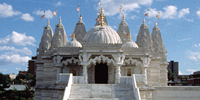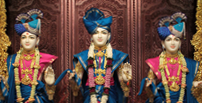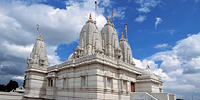Murti Information
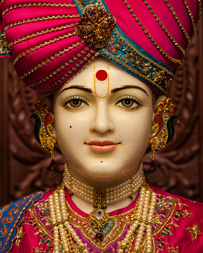

Bhagwan Swaminarayan (1781-1830)
- Bhagwan Swaminarayan manifested in northern India in 1781 to grant eternal liberation to countless souls, remove misguided religious practices, and dispel misinterpretations that had crept into Hinduism.
- Heading a socio-spiritual awakening, he established the Swaminarayan Sampradaya at the age of 20, introducing social reforms, serving the poor and needy, and preaching against superstitions, addictions and violence.
- During his lifetime, he initiated a total of 3,000 sadhus (ordained monks) and was recognised and worshipped as Purushottam (supreme God) by countless individuals.
- To continue his work of moral and spiritual regeneration, he promised to remain ever-present on earth through an unbroken succession of enlightened, God-realised gurus.
- To learn more about Bhagwan Swaminarayan, please click here.
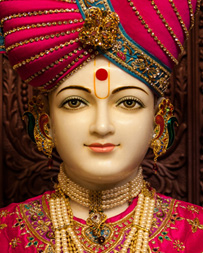

Gunatitanand Swami (1784-1867)
- Gunatitanand Swami was the first spiritual successor of Bhagwan Swaminarayan.
- He lived a life of an ideal sadhu, dedicated to the devotion of God, service of others, and sharing of profound wisdom.
- He was revealed by Bhagwan Swaminarayan to be Akshar, the perfectly enlightened devotee and the closest entity to God as extolled in the Vedas, Upanishads and Bhagavad Gita.
- As Akshar, he remains manifest on earth as the enlightened guru, helping aspirants attain God-realisation.
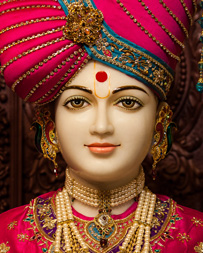

Gopalanand Swami (1781-1852)
- Gopalanand Swami was a senior sadhu-disciple of Bhagwan Swaminarayan.
- As a child, he mastered Ashtanga Yoga, the crowning glory of Yoga.
- He was an outstanding scholar and devoted himself to propagating the teachings of Bhagwan Swaminarayan.
- As a liberated soul, he is an inspiration to other devotees to follow in his exemplary devotion to and service of God.
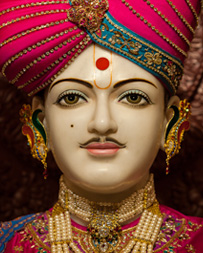

Ghanshyam Maharaj
- Bhagwan Swaminarayan was known by the name of Ghanshyam during his childhood.
- Ghanshyam renounced home at the age of 11 to embark on a 7-year, 7,000-mile spiritual journey across the length and breadth of India. Walking alone, barefoot, and with almost no possessions, he sanctified places of pilgrimage and inspired thousands to lead a life rooted in morality and spirituality.
- Ending his trek in the state of Gujarat, he built six majestic mandirs and inspired the creation of scores of scriptural texts by his sadhus.
- Bhagwan Swaminarayan’s spiritual teachings were recorded in the Vachanamrut – a collection of his discourses encapsulating Vedic wisdom and methods for implementing it in daily life.
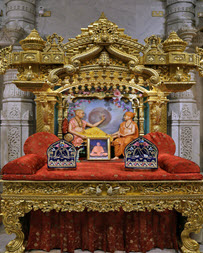

Sukh Shayya:
Bhagwan Swaminarayan with Gunatitanand Swami
- This depiction of Bhagwan Swaminarayan’s last days on earth shows him giving Gunatitanand Swami final instructions about leading the Swaminarayan Sampradaya.
- Those same instructions and empowerments have been passed down to each of the enlightened gurus in an unbroken spiritual lineage for over two hundred years.
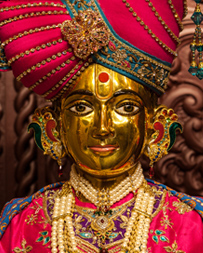

Harikrishna Maharaj
- Bhagwan Swaminarayan was also fondly called by the name of Harikrishna Maharaj.
- This murti (sacred image) is made from five pure metals: gold, silver, copper, iron and lead.
- As this mandir is dedicated to Bhagwan Swaminarayan, his murtis have been consecrated in various shrines under different names.
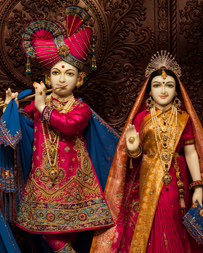

Shri Radha-Krishna
- Shri Krishna Bhagwan, one of the avatars of Vishnu Bhagwan, graced the world over 5,000 years ago.
- Though born into royalty, he was brought up as a cowherd. Thus, he is frequently seen pictured with cows and gopis – female devotees of the cowherd community.
- Playing the flute, he won the hearts and souls of devotees.
- His closest and dearest devotee is Shri Radha, who exemplifies unflinching love and total dedication.
- The teachings of Krishna Bhagwan are documented within the Bhagavad Gita, in which he outlines the basic tenets of true spirituality and encourages Arjun to defend righteousness.
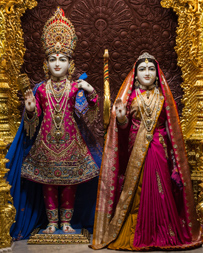

Shri Sita-Rama
- Shri Rama Bhagwan (Ramachandraji) is an avatar of Vishnu Bhagwan. His life teaches truth, justice, valour, compassion as well as other virtues of an ideal ruler, citizen, husband and son.
- Shri Sita, queen and devotee of Rama, exemplifies fidelity, true love, maternal perfection, faith as well as other virtues of an ideal wife and devotee.
- Banished to the forest for 14 years, Rama Bhagwan was accompanied by Sita and younger brother Lakshman.
- Sita was abducted by the evil king Ravan. Rama Bhagwan heroically rescued Sita with the help of Lakshman and an army led by Hanumanji. This is vividly chronicled in the poetic epic, the Ramayan.
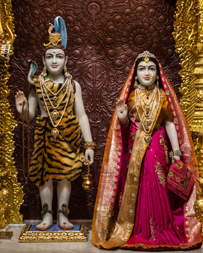

Shri Uma-Maheshwar
- Shri Shiva Bhagwan (Shankar Bhagwan) – also known as Maheshwar or Mahadev – represents the Destroyer aspect of the universe’s three stages; Brahma is the Creator; Vishnu, the Sustainer.
- Shiva Bhagwan is in the form of a yogi, adorned with the symbols of simplicity and asceticism.
- Ganga (the sacred River Ganges) is believed to have made her abode in Shiva Bhagwan’s matted locks and is depicted as flowing from there down to earth.
- Shiva Bhagwan ingested the poison that emerged from the ancient churning of the ocean; hence his bluish hue.
- Shri Parvati – also known as Uma or Shakti (the feminine power of Shiva Bhagwan) – is represented as his inseparable and dedicated devotee.
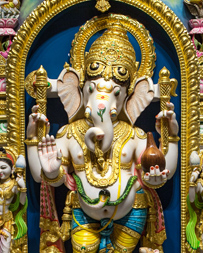

Shri Ganesh
- Shri Ganesh, much adored in Hinduism, is the son of Shiva and Parvati.
- He represents the vital aspect of Shiva’s divinity as the remover of obstacles and the bestower of good fortune; seekers look to him for wisdom.
- He is honoured at the start of various Hindu ceremonies.
- He cares for all beings, even an insignificant mouse.
Shivaling
- The rounded black stone is a Shivaling, worshipped as a representation of Shiva. It represents Infinity and Eternity.
Nandi
- Nandi the bull, a devoted servant of Shiva, symbolises the limitless effort and tolerance required for self-realisation.
Kach
- Another devout servant of Shiva, Kach the tortoise symbolises patience, perseverance and introspection.
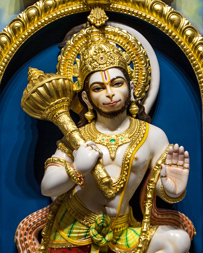

Shri Hanuman
- Shri Hanuman and his army helped Rama to defeat Ravan and rescue Sita.
- His virtues of inner strength, alertness, loyalty, humility, patience as well as other qualities of an ideal servant are an inspiration to all devotees.
- He inspires bravery and courage in fighting for righteousness.
- Seekers look to him for guidance and strength to overcome adversities; devotees pray to him asking for protection against evil forces.
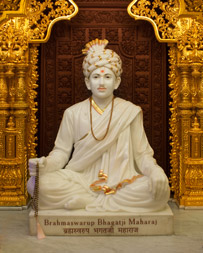

Bhagatji Maharaj (1829-1897)
- Bhagatji Maharaj was the second spiritual successor of Bhagwan Swaminarayan.
- His intense desire to worship God endeared him to many.
- He worked tirelessly to serve others despite being shunned and insulted by the ignorant.
- He lived a life of tremendous endeavour and unfailing faith according to the wishes of his guru Gunatitanand Swami.
- His ideal moral and spiritual enlightenment singled him out as successor to Gunatitanand Swami despite not being an ordained monk.
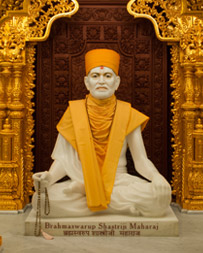

Shastriji Maharaj (1865-1951)
- Shastriji Maharaj was the third spiritual successor of Bhagwan Swaminarayan
- A profound scholar of Sanskrit and the Hindu scriptures, he was responsible for explaining the importance of the worship of Akshar and Purushottam – supreme God with his ideal devotee – as revealed by Bhagwan Swaminarayan.
- He overcame insurmountable odds to build five grand mandirs, consecrating within them the images of Gunatitanand Swami (Akshar) and Bhagwan Swaminarayan (Purushottam).
- In 1907, he formally established Bochasanwasi Shri Akshar Purushottam Swaminarayan Sanstha (BAPS).
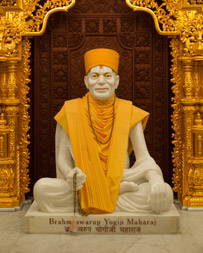

Yogiji Maharaj (1892-1971)
- Yogiji Maharaj was the fourth spiritual successor of Bhagwan Swaminarayan.
- He inspired spiritual activities beyond the borders of India, helping Hindus in Britain, North America and parts of Africa to preserve their faith and values.
- He initiated children’s and youth activities, promoting personal spirituality and service to society.
- In 1970, in Islington, he consecrated one of London’s first Hindu mandirs, prophesising the building of this present traditional stone mandir.
- His life was one of endless service, inspiring sermons and the sharing of his profound spiritual love.
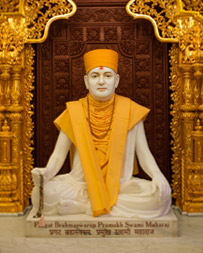

Pramukh Swami Maharaj (1921-2016)
- Pramukh Swami Maharaj was the fifth spiritual successor of Bhagwan Swaminarayan.
- This mandir, the fruit of his vision, blessings and hard work, was consecrated by him on 20 August 1995.
- Under his leadership, BAPS grew into an international spiritual and humanitarian organisation with over 3,850 centres worldwide.
- He travelled throughout the world, dedicating his life to the well-being of others, fostering love, peace, harmony, righteousness, faith in God and service to humanity.
- With his genuine care and compassion, he is remembered as a “people’s guru”, reaching out to all, irrespective of colour, class, creed or age.
- He was loved and respected as one of Hinduism’s great spiritual teachers, living by and preaching the message: “In the joy of others lies our own.”
- To learn more about Pramukh Swami Maharaj, please click here.
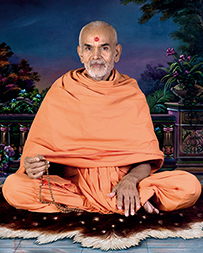

Mahant Swami Maharaj (b. 1933)
- Mahant Swami Maharaj is the sixth spiritual successor of Bhagwan Swaminarayan and present guru of BAPS Swaminarayan Sanstha.
- He served for over six decades under the guidance of gurus Yogiji Maharaj and Pramukh Swami Maharaj. His outstanding virtues of austerity, devotion, humility and service earned him their innermost blessings.
- Through his simple and serene spirituality and profoundly insightful discourses, he guides devotees and well-wishers around the world towards a virtuous, God-centric life.
- To learn more about Mahant Swami Maharaj, please click here.
















